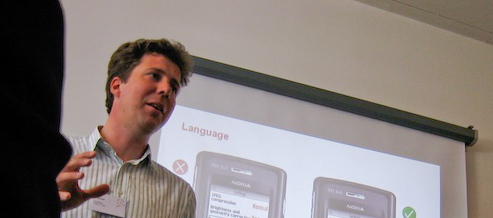The Idlemode team descended on CTIA last month to check out the latest in the world of wireless. While there was plenty of gadgetry to gawk at, we found the six most interesting trends and takeaways to be these.
Video
Video, and what was being done with it, was seemingly on everybody’s mind. The biggest buzz went to a Qualcomm technology called MediaFLO. It’s a solution designed to “efficiently and cost-effectively distribute mass volumes of high-quality mobile multimedia to wireless subscribers,�? according to the company; in a nutshell, it’s an ingenious way to use a DVR model on a phone. While a DVR is a hard drive, and of course this isn’t, it does record media in the background much like a DVR does. When you’re ready, you just browse your phone and watch. In our opinion, this is an ingenious way to combat the constraints of bandwidth.
Consumer Interaction
There was plenty of discussion about how consumer behavior will affect the adoption of new wireless features. For example, if video is the Next Big Thing, what are the relevant customer behaviors to focus on?
A cautionary tale might be found in the fact that several movie studios and retailers recently cut back support of Sony’s proprietary Universal Media Discs (UMD), aimed at the Playstation Portable market, due to poor sales. Despite the PSP’s beautiful screen – we think it’s arguably the best on any device out there – users may to be rejecting the idea of watching feature-length films on a mobile device. Alternatively, perhaps Sony shot itself in the foot by requiring users to deal with yet another proprietary format.
The bottom-line focus is whether people will actually embrace full-length video on a portable device.
Killer Apps
From our vantage point, it seemed as if a lot of the energy at CTIA was focused on what applications were being created for the wide range of devices showcased. What really caught our eye were apps that enable you to use your camera’s phone as a bar-code reader in order to conduct a transaction, obtain instant review information, or comparison shop. Players in this field include Nextcode Corporation, Ontela and its PicDeck technology, Scanbuy and its ScanZoom technology, and Qualcomm’s BREW-based EZ Appli application, which was launched by KDDI and Okinawa Cellular and is starting to gain traction in Japan.
Interface Design
While the range of apps we saw was great, we found them to be lacking from an interface design perspective. It’s evident that there is a need for better interfaces, better graphics, and better consideration of the interaction flow as part of the interface. Most of them are very minimalist and very basic; it’s obvious they’ve been driven more from a technical feature perspective rather than a rich interface perspective, with a focus on concept rather than execution. We think it’s important that the industry realizes that along with functionality, you have to create an effective and engaging interface.
The IP Switch
Plenty of people were talking about the ramifications of the switch to IP from traditional telephony. It really changes the equation for the carriers. Right now, they can charge 10 cents a pop for text messaging – but what happens when the phone becomes just a bitpipe to the network? Or when anyone can write an app that allows you to communicate freely over the Internet? All of a sudden, the billing models change, and even the playing field for voice services could undergo some dramatic makeovers. They are scrambling to figure out how to avoid a commoditization of their services. On the other hand, users and handset manufacturers are excited about the benefits they could enjoy.
What’s Up Apple’s Sleeve?
Although Apple is playing it close to the vest and hasn’t said much of anything about the wireless space, the possibilities were on everyone’s mind. Several panelists were speculating about what would happen if Apple decided to jump in with a handset – what it would be like, what services (if any) would Apple provide, and how it might change the industry. A panel of top manufacturers’ representatives said that while they’re interested in seeing what Apple might come up with, they’re not anticipating anything earth-shattering because creating an RF device is harder than building a memory-based one. By contrast, a Microsoft representative opined that an Apple device could set a new bar for the industry. Only time will tell what, if any, impact Apple might have…but in this iPod-crazy world, we’re not counting them out.
Add this to digg, del.icio.us, etc.



